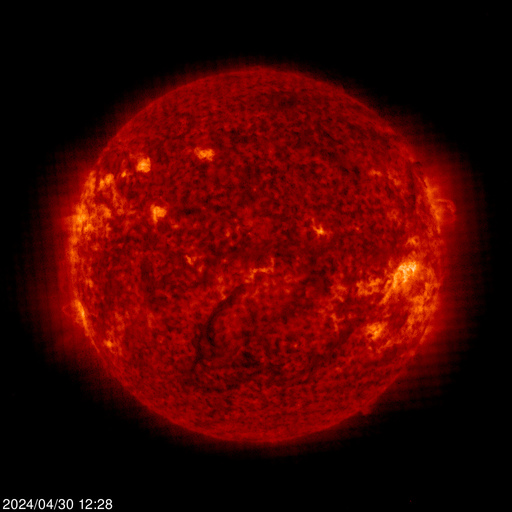SIDC Ursigram
3-day-forecast of solar and geomagnetic activity.| Source | SIDC (RWC-Belgium) |
| Frequency | Daily |
| Format | Encoded data (ISES) |
| Mail header | SIDC Ursigram |
| SIDC code | meu |
Archive
Latest issue
:Issued: 2025 Sep 07 1231 UTC :Product: documentation at http://www.sidc.be/products/meu #--------------------------------------------------------------------# # DAILY BULLETIN ON SOLAR AND GEOMAGNETIC ACTIVITY from the SIDC # # (RWC Belgium) # #--------------------------------------------------------------------# SIDC URSIGRAM 50907 SIDC SOLAR BULLETIN 07 Sep 2025, 1230UT SIDC FORECAST SOLAR FLARES : M-class flares expected (probability >=50%) GEOMAGNETISM : Active conditions expected (A>=20 or K=4) SOLAR PROTONS : Quiet PREDICTIONS FOR 07 Sep 2025 10CM FLUX: 144 / AP: 013 PREDICTIONS FOR 08 Sep 2025 10CM FLUX: 142 / AP: 008 PREDICTIONS FOR 09 Sep 2025 10CM FLUX: 140 / AP: 007 Solar Active Regions and flaring: Solar flaring activity was moderate over the past 24 hours, with 1 M-class flare identified. The largest flare was a M1.2 flare (SIDC Flare 5442) peaking on September 06 at 22:15 UTC, which was produced by SIDC Sunspot Group 624 (NOAA Active Region 4207). A total of 9 numbered sunspot groups were identified on the disk over the past 24 hours. SIDC Sunspot Group 624 (NOAA Active Region 4207) is the largest and most magnetically complex (Beta-Gamma) region on disk and produced most of the flaring activity in the last 24 hours. Solar flaring activity is expected to be moderate over the next 24 hours, with M-class flares likely and a small chance for X-class flares. Coronal mass ejections: No Earth-directed Coronal Mass Ejections (CMEs) have been detected in the available coronagraph images. Solar wind: Over the past 24 hours the solar wind conditions at Earth were disturbed, due to the arrival of a coronal mass ejection (CME) associated with a faint halo CME observed in SOHO/LASCO-C3 images on September 04, and the ongoing influence of a high-speed stream (HHS) associated with SIDC Coronal Hole 123. On September 06 at 13:50 UTC the solar wind speed jumped from 501 km/s to 620 km/s and the total interplanetary magnetic field jumped from 10 nT to 22 nT. Over the entire period the Bz reached a minimum of -10 nT. At the end of the period the solar wind speed is around 520 km/s and the total interplanetary magnetic field is around 9 nT. The phi-angle was mainly in the positive sector (directed away from the Sun), with periods in the negative sector. The solar wind conditions are expected to remain enhanced in the next 24 hours, due to the waning influence of the ICME and the high-speed stream. Geomagnetism: The geomagnetic conditions over the past 24 hours reached minor storm conditions globally and locally (Kp 5 & K BEL 5). Active conditions are expected for the next 24 hours. Proton flux levels: Over the past 24 hours, the greater than 10 MeV GOES proton was at background levels and is expected to remain so over the next days. Electron fluxes at GEO: The greater than 2 MeV electron flux, as measured by the GOES-18 and GOES-19 satellites, were below the 1000 pfu threshold in the last 24 hours. The 2 MeV electron flux is expected to cross the threshold during the next 24 hour. The 24-hour electron fluence was at normal levels and is expected to remain at normal levels over the next 24 hours.
Zdroj : SIDC Ursigram |
Předpověď sluneční aktivity pro období : September 05 - September 11, 2025
Zdroj : http://www.asu.cas.cz/~sunwatch |
Poslední fotografie ze SOHO / SDO:
Různé barvy snímků prozrazují odlišné vlnové délky - každá
vlnová délka je vyzařována plynem o určité teplotě: oranžová: 80 000 °C,
modrá: 1 000 000 °C, zelená: 1 500 000 °C, hnědá: 2 500 000 °C.










